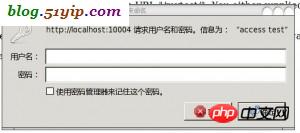
We often see this phenomenon, see the picture below

apache page access control
Why should we carry out such control? People look at different things and protect information. Although this kind of protection is relatively low-level, it is still somewhat useful.
First, use the htpasswd command to generate the permission control file
[zhangy@BlackGhost test]$ htpasswd -c ./access tank //生成一个密码文件 ,-c是新建一个文件 htpasswd -h可查看 New password: //提示输入密码 Re-type new password: //重复密码 Adding password for user tank [zhangy@BlackGhost test]$ cat access //查看一下密码文件 tank:Uj5B3qIF/BNdI //用户名是明文的,密码是加密的。
[zhangy@BlackGhost test]$ htpasswd -c ./access tank //生成一个密码文件 ,-c是新建一个文件 htpasswd -h可查看 New password: //提示输入密码 Re-type new password: //重复密码 Adding password for user tank [zhangy@BlackGhost test]$ cat access //查看一下密码文件 tank:Uj5B3qIF/BNdI //用户名是明文的,密码是加密的。
The password file is now generated.
2. Page access control method
1, which can be configured by modifying httpd.conf or httpd-vhosts.conf
listen 10004 NameVirtualHost *:10004 <VirtualHost *:10004> DocumentRoot "/home/zhangy/www/test" ServerName *:10004 BandwidthModule On ForceBandWidthModule On Bandwidth all 1024000 MinBandwidth all 50000 LargeFileLimit * 500 50000 MaxConnection all 2 ErrorLog "/home/zhangy/apache/blog.51yip.com.com-error.log" CustomLog "/home/zhangy/apache/blog.51yip.com-access.log" common //看一下,下面的配置 <Directory /home/zhangy/www/test> AuthType Basic AuthName "access test" AuthUserFile /home/zhangy/www/test/access Require valid-user </Directory> </VirtualHost>
listen 10004 NameVirtualHost *:10004 <VirtualHost *:10004> DocumentRoot "/home/zhangy/www/test" ServerName *:10004 BandwidthModule On ForceBandWidthModule On Bandwidth all 1024000 MinBandwidth all 50000 LargeFileLimit * 500 50000 MaxConnection all 2 ErrorLog "/home/zhangy/apache/blog.51yip.com.com-error.log" CustomLog "/home/zhangy/apache/blog.51yip.com-access.log" common //看一下,下面的配置 <Directory /home/zhangy/www/test> AuthType Basic AuthName "access test" AuthUserFile /home/zhangy/www/test/access Require valid-user </Directory> </VirtualHost>
2, we can use the .htaccess file for control
Create a .htaccess file under the root directory of test
[zhangy@BlackGhost test]$ vi .htaccess //打开个文件 ,添加权限内容 [zhangy@BlackGhost test]$ cat .htaccess //下面就是.htaccess的内容 AuthType Basic AuthName "access test" AuthUserFile /home/zhangy/www/test/access Require valid-user
[zhangy@BlackGhost test]$ vi .htaccess //打开个文件 ,添加权限内容 [zhangy@BlackGhost test]$ cat .htaccess //下面就是.htaccess的内容 AuthType Basic AuthName "access test" AuthUserFile /home/zhangy/www/test/access Require valid-user
If you want to Many people set different user names and passwords. It is more convenient to use AuthGroupFile to set options
3. Access control can also be performed without a password file
define('ADMIN_USERNAME','tank'); // Admin Username
define('ADMIN_PASSWORD','tank'); // Admin Password
//log check
if (!isset($_SERVER['PHP_AUTH_USER']) || !isset($_SERVER['PHP_AUTH_PW']) ||
$_SERVER['PHP_AUTH_USER'] != ADMIN_USERNAME ||$_SERVER['PHP_AUTH_PW'] != ADMIN_PASSWORD) {
Header("WWW-Authenticate: Basic realm=/"access test/"");
Header("HTTP/1.0 401 Unauthorized");
echo <<<EOB
<html><body>
<h1>Rejected!</h1>
<big>Wrong Username or Password!</big>
</body></html>
EOB;
exit;
}define('ADMIN_USERNAME','tank'); // Admin Username
define('ADMIN_PASSWORD','tank'); // Admin Password
//log check
if (!isset($_SERVER['PHP_AUTH_USER']) || !isset($_SERVER['PHP_AUTH_PW']) ||
$_SERVER['PHP_AUTH_USER'] != ADMIN_USERNAME ||$_SERVER['PHP_AUTH_PW'] != ADMIN_PASSWORD) {
Header("WWW-Authenticate: Basic realm=/"access test/"");
Header("HTTP/1.0 401 Unauthorized");
echo <<<EOB
<html><body>
<h1>Rejected!</h1>
<big>Wrong Username or Password!</big>
</body></html>
EOB;
exit;
}The method used above is PHP, I think there are other languages too. You can write the above code into a file for sharing and inclusion, or you can encapsulate it into the base, so that no matter what page is accessed, access control can be carried out.
The above is the detailed content of 3 methods for php page access control. For more information, please follow other related articles on the PHP Chinese website!
 Windows checks port occupancy status
Windows checks port occupancy status
 How to download Razer mouse driver
How to download Razer mouse driver
 Windows 11 my computer transfer to the desktop tutorial
Windows 11 my computer transfer to the desktop tutorial
 The difference between fprintf and printf
The difference between fprintf and printf
 what is vulkan
what is vulkan
 Priority order of operators in c language
Priority order of operators in c language
 How to embed CSS styles in HTML
How to embed CSS styles in HTML
 Why can't the video in ppt play?
Why can't the video in ppt play?
 latex usage
latex usage




